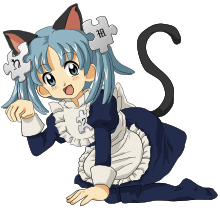Catgirl
| Look up catgirl in Wiktionary, the free dictionary. |

An anime-style catgirl
A catgirl (nekomimi: 猫耳, literally cat ear[s]) is a female character with cat traits, such as cat ears, a cat tail, or other feline characteristics on an otherwise human body. Catgirls are found in various fiction genres and in particular Japanese anime and manga.[1]
Contents
1 History
2 Reception
3 See also
4 References
5 External links
History
The portrayal of cat-girls goes back until at least 1924 when Kenji Miyazawa (Japanese author of children's literature in the early Shōwa period of Japan) created 水仙月の四日 (The 4th of narcissus month) where the first "Modern Day" Nekomimi Cat girl appears as 雪婆んご in the story, a beautiful, cat-eared woman.[2] The first anime titled The King’s Tail (Osama no Shippo) involving cat-girls was made in 1949 by Mitsuyo Seo. In America, Catwoman and Cheetah were created by DC Comics that date back to 1940.[3]
In 1978, cat-girls were further made popular when the series The Star of Cottonland (Wata no Kuni Hoshi) started.[4] By the 1990s catgirls were common in Japanese anime and manga.[5] Cat-girls have since been featured in various media worldwide. Enough of a subculture has developed for various themed conventions and events to be held around the world, such as Nekocon.[6]
Reception
Japanese philosopher Hiroki Azuma has stated that catgirl characteristics such as cat ears and feline speech patterns are examples of moe-elements. Azuma argued that although some otaku sexual expression involves catgirl imagery, few otaku have the sexual awareness to understand how such imagery can be perceived as perverted.[5][7]
In a 2010 critique of the manga series Loveless, the feminist writer T. A. Noonan argued that, in Japanese culture, catgirl characteristics have a similar role to that of the Playboy bunny in western culture, serving as a fetishization of youthful innocence.[8]
See also
- List of catgirls
- Animal roleplay
- Moe anthropomorphism
References
^ David Okum (2004-03-24), "Cat Girl", Manga Madness, p. 72, ISBN 978-1-58180-534-5.mw-parser-output cite.citation{font-style:inherit}.mw-parser-output q{quotes:"""""""'""'"}.mw-parser-output code.cs1-code{color:inherit;background:inherit;border:inherit;padding:inherit}.mw-parser-output .cs1-lock-free a{background:url("//upload.wikimedia.org/wikipedia/commons/thumb/6/65/Lock-green.svg/9px-Lock-green.svg.png")no-repeat;background-position:right .1em center}.mw-parser-output .cs1-lock-limited a,.mw-parser-output .cs1-lock-registration a{background:url("//upload.wikimedia.org/wikipedia/commons/thumb/d/d6/Lock-gray-alt-2.svg/9px-Lock-gray-alt-2.svg.png")no-repeat;background-position:right .1em center}.mw-parser-output .cs1-lock-subscription a{background:url("//upload.wikimedia.org/wikipedia/commons/thumb/a/aa/Lock-red-alt-2.svg/9px-Lock-red-alt-2.svg.png")no-repeat;background-position:right .1em center}.mw-parser-output .cs1-subscription,.mw-parser-output .cs1-registration{color:#555}.mw-parser-output .cs1-subscription span,.mw-parser-output .cs1-registration span{border-bottom:1px dotted;cursor:help}.mw-parser-output .cs1-hidden-error{display:none;font-size:100%}.mw-parser-output .cs1-visible-error{font-size:100%}.mw-parser-output .cs1-subscription,.mw-parser-output .cs1-registration,.mw-parser-output .cs1-format{font-size:95%}.mw-parser-output .cs1-kern-left,.mw-parser-output .cs1-kern-wl-left{padding-left:0.2em}.mw-parser-output .cs1-kern-right,.mw-parser-output .cs1-kern-wl-right{padding-right:0.2em}
^ "Suisenzuki no yokka". www.aozora.gr.jp. Retrieved March 15, 2015.
^ Wallace, Daniel (2010). "1940s". In Dolan, Hannah. DC Comics Year By Year A Visual Chronicle. Dorling Kindersley. p. 31. ISBN 978-0-7566-6742-9.The first issue of Batman's self-titled comic written by Bill Finger and drawn by Bob Kane, represented a milestone in more ways than one. With Robin now a partner to the Caped Crusader, villains needed to rise to the challenge, and this issue introduced two future legends: the Joker and Catwoman.
^ Jaqueline Berndt (1995). Phänomen Manga : Comic-Kulture in Japan (in German). Berlin: Edition q. p. 111. ISBN 3-86124-289-3.
^ ab Azuma, Hiroki (2009). Otaku : Japan's database animals. Translated by Abel, Jonathan; Kono, Shion (English ed.). Minneapolis: University of Minnesota Press. pp. 47, 89. ISBN 9780816668007. OCLC 527737445.
^ "After Action Report". The Virginian-Pilot. 2007-10-07. Retrieved 2013-02-03.
^ Galbraith, Patrick W. "Moe and the Potential of Fantasy in Post-Millennial Japan". Electronic Journal of Contemporary Japanese Studies. 9 (3). Retrieved 2018-05-23.
^ Noonan, T. A. (Fall 2010). ""I Can't Get Excited for a Child, Ritsuka": Intersections of Gender, Identity, and Audience Ambiguity in Yun Kôga's Loveless" (PDF). MP: An Online Feminist Journal. MP: An Online Feminist Journal. 3 (2). ISSN 1939-330X. Retrieved 10 February 2013.
External links
| Wikimedia Commons has media related to Catgirls. |
Cat Girl at TV Tropes